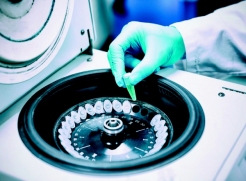Challenges in Cell Harvesting Prompt Enhancements

A key challenge in cell harvesting is how to deal with higher cell densities. The past decade has seen the biopharmaceutical industry move toward significantly higher titers, and, as a result, higher cell densities. Biomanufacturers have been shifting from large stainless-steel bioreactors in the thousands-of-liters range to smaller, disposable bioreactors (2).
The need to address this bottlenecking issue drives innovations in cell harvesting techniques, including innovations in centrifugation and filtration techniques/equipment. Among the innovations are continuous processes/techniques that can mitigate the stress of high cell densities.
Centrifugation challenges
The centrifugation step uses the density difference between cells and the surrounding fluid, accelerating the separation and settling of cells. Industrial applications typically use disk-stack centrifuges to separate cells and associated debris from the medium, which offers a continuous operation and makes for consistent throughput (1).
Disk-stack continuous centrifuges can remove cells and large cell debris, but cells can be disrupted during this process, particularly if the feedstock is a low-cell viability culture fluid. Submicron-size particles are difficult to remove by centrifuge, which increases the burden on the following depth filtration step (3).
The centrifugation process’ clarification efficiency is impacted by harvest parameters including centrifuge feed rate, G-force, bowl geometry, operating pressures, discharge frequency, and ancillary equipment used in the transfer of cell-culture fluid to the centrifuge. Cell-culture process characteristics, such as peak cell density, total cell density, and culture viability during the culture process and at harvest, also impact separation performance during centrifugation (3).
Because harvesting cells is a delicate process that holds the risk of lysing the cells if the separation is not done gently, Alfa Laval, a supplier of products and solutions for heat transfer, separation, and fluid handling, addressed the problem by developing a modern cell-culture harvesting system, Culturefuge 100. The system uses a hollow spindle technology that provides a method of continuous cell harvesting under hermetic conditions (1).
The system consists of a disk-stack, high-speed separator, piping for service and process liquids, an integrated electrical system with starter, programmable logic controller (PLC) control, and pneumatic unit. The system also includes an optional steam-serializable pump for solid-phase transport.
For continuous processing, feed material enters the Culturefuge 100 via a hollow spindle feed inlet and gradually moves upwards. This minimizes the shear forces on the liquids and prevents cell lysis. The feed zone is completely filled with rotating liquid, creating an air-tight environment. Because the system is completely hermetic through to the outlet, the risk of contact with air or the external environment is eliminated (1).
Other improvements in mammalian cell harvesting that have been developed with the use of fully hermetic centrifuges include management of the air-liquid interface at both the inlet and outlet zones by applying sufficient back pressure, which allows the system to achieve an air-free centrate while at the same time avoiding overflow-inducing high pressures. This hermetic design uses mechanical seals to fully isolate product fluid from the outside air, allowing the centrifuge system to be completely filled with liquid and eliminating any air-liquid interface inside the centrifuge (3).
Coupled with head pressure applied to the bioreactor, a completely sealed system such as this allows the flow to be controlled at the outlet of the machine, which removes the need for pumps and flow-control valves from the inlet piping. These design improvements have reduced the amount of cell lysis in a hermetically designed centrifuge by more than 50% (3).
Filtration challenges
Filtration processes during cell harvesting also face similar challenges. As with centrifugation, filtrations processes, as well as filter manufacturers, have been challenged by the increasing titers and cell densities ubiquitous now in upstream cell-culture processing. The higher titers and cell densities made the initial clarification of monoclonal antibody (mAb) product more difficult, driving the need for filtration technologies that can handle the large amounts of cell mass.
To address the issues arising from higher titers and higher cell densities, biomanufacturers are now also introducing additives to the bioreactor to facilitate the clarification steps. This results in an added burden to filtration processes, however, which must have the capacity to handle the additive material as well as the mAb product (2).
Other challenges that innovations need to address in filtration processes include higher expectations for viral clearance, the increasing use of single-use technologies and the implementation of these single-use technologies on a larger scale, and the need for filtration technology that works with a variety of feedstocks (besides mammalian cells) at the primary clarification step. Some responses to these challenges include the development of higher-capacity, higher-performance filters that are based on new materials, membrane structures, and filter designs (2).
In cell harvesting, depth filters can be used in conjunction with centrifugation or another primary separator, such as tangential flow filtration, as well as being applied directly to whole cell broth. Depth filtration is most frequently used after the centrifugation process because centrifugation is limited in its ability to remove low-particle size material. Depth filtration applied in this case involves the use of filters with a pore size ranging from 0.1 µm to 4 µm and comprised of two distinct layers. The upper layer captures coarse particles, and the bottom layer captures smaller particles, thus reducing premature plugging and increasing the filtration capacity (3).
Through the use of a number of complementary mechanisms, depth filtration allows contaminant removal, sieving, and electrokinetic adsorption, in addition to hydrophobic interactions. This makes the technique a potent tool for mAb purification (3).
References
1. P. Rose, “Cell Harvesting—Getting Cultural,” www.filtsep.com/food-and-beverage/features/cell-harvesting-getting-cultural, accessed April 30, 2018.
2. C. Challener, BioPharm International 28 (5) 2015.
3. H.F. Liu et. al, “Recovery and Purification Process Development for Monoclonal Antibody Production,” MAbs online, DOI: 10.4161/mabs.2.5.12645, Sept. 1, 2010.